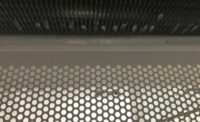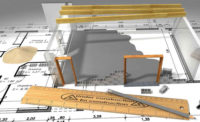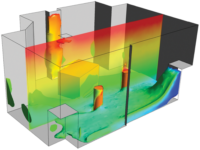In our previous article, “Debunking Myths of Active Chilled Beams: What You Thought You Knew – But Were Wrong, Part 1,” engineers from SmithGroup and Dadanco, along with senior sales engineers from Varitec, teamed up to dispel the intuitive concern many owners and engineers have regarding condensation formation on active chilled beams (ACBs) when space dew points are higher than the supply water temperatures serving ACBs. These tests proved it takes several hours for condensation to form on the ACB coil and fins to a point where it becomes a concern. This leaves ample time for a well-designed control system to react to prevent water droplets from forming and falling from a chilled beam coil. Although this question was answered, there are still open concerns about using ACBs appropriately for certain applications and whether or not they will effectively perform for various types of zones, specifically for zones with large sensible and latent load swings.
The previous article posed other questions and concerns engineers and owners have regarding the use of chilled beams, including, “What happens when you introduce a large sensible and latent load to a space, such as a conference room or waiting room, all at once?”
In this article, “Debunking Myths of Active Chilled Beams: What You Thought You Knew – But Were Wrong, Part 2,” the SmithGroup, Dadanco, and Varitec team designed two tests to analyze ACB response time. Test No. 1 examined what occurred within a space and chilled beam upon a sudden increase in latent load in a small conference room. Test No. 2 examined what happened to the environment of a large conference when there is a rapid spike in a space’s total load. This article covers the tests that were performed, provides analysis of the data, offers a summary of the findings, and addresses the following questions:
-
How will an ACB perform in areas subjected to wide load swings?
-
Will sweating occur at an ACB coil or supply water piping connection when moisture levels rapidly increase during occupancy?
-
Can an ACB adequately respond when there is a sudden rise in space total load to maintain room design humidity levels and thermal comfort?
Unlike conventional mixed air systems that use air as the heat transfer medium to satisfy the total load of a conditioned building, “decoupled” chilled water systems split the latent and sensible loads and drive zone sensible loads directly to chilled water supplied through local coils. Since water is a denser heat transfer medium than air and can hold 600 times more Btu per pound of heat transfer medium, it requires significantly less volume of water than air to maintain space temperatures. Energy efficiency is gained by reducing fan horsepower that would otherwise be required to remove sensible heat from a building using an air-side HVAC design. Chilled beam systems are typically coupled with either dedicated outdoor air systems (DOAS), standard chilled water air-handling units, or energy recovery units to control a building’s latent load. Chilled beams are selected and laid out to satisfy space sensible loads. Consequently, by “decoupling” the sensible and latent load, a building owner can reap 20%-40% or more in energy savings when compared to an ASHRAE 90.1 -2013 baseline system.
TEST No. 1 - Latent Load Rapid Increase (Small conference room)
To simulate a small conference room, Dadanco used its environmental test chamber with five DIN-men configured to the following design conditions (Figure 1).
- Chilled Beam: Dadanco Model ACB40 24-by-120-inch 2-pipe (located in the center of the room)
- Room Air Condition: 75°F/50% RH (55° dew point)
- Occupancy/Latent Load: Five occupants (approximately 1,000 Btu/h latent load)
- Primary Air Conditions:
- Total Flow: 150 cfm
- Entering Air Temperature: 55° DB @ 53° dew point
- Entering Chilled Water Temperature: 58.8°
- Chilled Water Flow Rate: 1 gpm
- Test Duration: 68 minutes
- Controls: Primary air and chilled water flow rates were constant volume
TEST No. 1 - Setup & Procedure
The simulated conference room before occupancy was designed to a steady state of 73.5°/51% RH. The ACB was served by ducted primary air delivered at 57° DB and 58° chilled water at a flow rate of 1 gpm, while heat was applied to the five DIN-men. A larger than necessary beam was used to reduce the beam induction ratio of room-side air, thereby reducing the air velocity across the coil, causing a greater likelihood of coil condensation to occur should room dew point exceed the chilled water temperature. The entering chilled water temperature was measured by a temperature sensor inserted into a thermal well in a valve that is connected to the chilled beam coil. A pair of temperature and RH sensors were located at each end of the chilled beam, approximately level with the ACB face. The two temperature sensors were averaged for the room temperature and the two RH sensors were averaged for the relative humidity value. Room air dew point was a calculation based on these averaged values. After achieving steady state, five occupants entered the room, sat down, started working on their laptops, and began conversing for the duration of the test. To maintain the sensible load to the space as the occupants arrived, the DIN-men were deactivated, thereby creating a rapid spike only in the latent load. Since the test is meant to demonstrate a sudden shift in moisture levels when there is a rapid increase of occupants and consequent latent gain, the room dry bulb temperature was allowed to float. Having a lower room temperature also more closely reflects actual space conditions when occupants adjust thermostat setpoints lower than room design conditions to enhance thermal comfort. Consequently, this test closely resembles real-world conditions, demonstrating worst-case humidity. The colder a room becomes the closer air within the conditioned space approaches the saturation curve on a psychrometric chart. This environment is more conducive to condensation forming should there be a loss of humidity control. During occupancy, the ACB coil and supply piping connection were inspected and photographed approximately every 10 minutes in order to document any condensate formation that occurred.
TEST No. 1 - Temperature and Humidity Data
In this simulation, the two most important parameters are the difference in absolute humidity between the room air and primary air and the difference between the room dew point temperature and entering water temperature. Figure 2 represents room design conditions and performance throughout the duration of the test. At approximately 3:23 p.m., occupants entered the room. At that time, the DIN-men were deactivated and the air-handling unit was enabled. At approximately 3:25, one can see in Figure 2 that the air-handling unit primary air begins to control space latent load through primary air dew point depression. The oversized chilled beam causes a decrease in room temperature. During the test time, the graph clearly demonstrates how lowering and maintaining primary air dew point effectively controlled spae dew point after the room sensor read an increase in room latent load.
Table 1 provides a comparison between ideal conditions for a space cooled by chilled beams to the actually measured parameters and calculations showing initial conditions, min/max read points, and the calculated averages.
TEST No. 1 - Results
-
Room Dew Point: The “actual initial” room reading was very close to the design ideal and, as expected, was the minimum measured point during the test when there were no occupants. When occupied, the maximum reading shows a spike in moisture at a room dew point to 56.5°.
-
Primary Air Dew Point: The “actual initial” reading was higher than the ideal condition to simulate the effects of more humid air than would otherwise be designed. However, when occupied, the primary air dew point was reduced to 53° to more closely conform to the ideal design value of 51°. Though higher than ideal, reducing primary air to 53° clearly demonstrates how properly designed primary air moisture levels is necessary to control room latent loads.
-
Entering Water Temperature: The entering chilled water temperature stayed relatively constant throughout the test.
-
Difference: Room Dew Point vs. Primary Air Dew Point (Room DP – PA DP): Humidity is being regulated by controlling primary air dew point, therefore, the minimum difference occurs at the initial condition. As primary air dew point is reduced to control space humidity when the room is occupied, the differential increases to 3.4° to keep room dew point constant.
-
Difference: Room Dew Point vs. Primary Air Dew Point (Room DP: It is ideal to keep room dew point 2°-3° below the entering water temperature to prevent condensation from forming at the beam coil. Since the room atmosphere was dry when there were no occupants, the “actual initial” reading exceeds the ideal value by 5.4°. When occupants arrive, the minimum differential drops to 2.1°, which is well above room dew point, thereby preventing condensation from forming at the coil.
-
Figures 3 and 4: These photos show the supply coil connection and coil finned area at approximately 4:30 p.m., 68 minutes after initiating the test. Photos were also taken before the occupants entered the room, but since there was no condensation formation throughout the duration of the test, they were omitted. As can be clearly seen, there was no evidence of condensation forming after the beams were subjected to rising dew point temperatures during the duration of the test.
TEST No. 2 - Sensible/Latent Load Rapid Increase: (Large conference room)
To simulate conditions of a larger conference room subjected to an even wider load swing of 20 occupants, Dadanco used its environmental test chamber with 12 DIN-men and a humidifier configured to the following design conditions (Figure 5):
- Chilled Beam: Dadanco Model ACB40 24-by-72-inch 2-pipe (located in the center of the room)
- Room Air Condition: 72°/57% RH (56° dew point)
- Occupancy/Latent Load: 20 Occupants (approximately 8,100 Btu/h Sensible and 3,100 Btu/h latent load)
- Primary Air Conditions:
- Total Flow: 260 cfm (130 per ACB)
- Entering Air Temperature: 65° DB @ 48° dew point (constant)
- Entering Chilled Water Temperature: Approximately 58°
- Chilled Water Flow Rate: 1 gpm per ACB, 2 gpm total
- Test Duration: 65 minutes
- Controls: Primary air and chilled water flow rates were constant volume
TEST No. 2 - Setup & Procedure
The simulated conference room, served by two Dadanco ACB-40 ACBs, was brought to a steady state condition of 74°/50% RH before occupancy. Each of the two ACBs was served by a dedicated primary air duct supplying 130 cfm of air at 65° DB and 48° dew point. (Primary air temperatures of 55°-60° are more typical, but this test used 65° air to demonstrate that elevated supply air temperatures, when properly applied, also provide quick response for zones challenged by large load swings.) Each of the two ACBs was supplied by separate air handlers drawing 100% recirculated air from the lab.
Provided both HVAC options are designed to deliver the same amounts of sensible and latent cooling, recovery times between all-air and chilled beam systems will be relatively equal.
Primary airflow remained constant to both ACBs before and during the test, providing 25% of the total space’s sensible cooling requirement. The other 75% of sensible cooling occurred at the ACB coils. Chilled water was supplied at a flow rate of 1 gpm per beam for a total flow of 2 gpm at 58° entering water temperature (EWT). To demonstrate the response effectiveness of ACBs in large conference rooms subjected to immediate occupancy, the humidifier and DIN-Men were enabled simultaneously to immediately generate a total space load. The chilled beam valves were opened directly after to simulate the fastest-acting scenario. It took approximately 15 seconds for ACB coil water to be flushed out by the entering 58° chilled water. (It should be noted that chilled water valves should be located near the ACBs to minimize the time it takes for the ACB coils to be uniformly served by the 58° chilled water. Every ACB does not require a control valve, only controlled zones.)
TEST No. 2 - Results
Figure 6 clearly demonstrates the rapid speed of response properly designed and sized chilled beams deliver when ACB valves drive to an open position as a zone is subjected to a rapid increase in sensible and latent loads. (The initial room dew point was lower than expected likely due to a nonuniformity of temperature and humidity throughout the space depending on where in the room these values were being measured. Dew points were calculated based on temperature and humidity readings.)
In fact, one could argue a chilled beam system may result in a faster cooling response time should the appropriate primary airflow rate be delivered at an even lower dew point than utilized in these tests or traditional systems supplying 55° DB/54° WB air.
The steady state room temperature decreased from 74° to 72° in less than 15 minutes. This was an unexpected result, but, after further thought, it supports the concept that a properly designed primary air system compensates proprotionally to the increase in space sensible load. Room humidity does increase slightly when the humidifier is enabled but levels off quickly and closely maintains a room dew point of between 53° to 54° or 45% RH. It’s very important to understand latent cooling in these spaces is controlled by the primary air not by the ACB coil. Supplying air at an appropriately designed low dew point will allow a conditioned space to maintain humidity levels in conformance to ASHRAE Standard 55, even when subjected to a rapid substantial rise in moisture levels to the space.
TEST No. 1 and Test No. 2 - Conclusion
After more than an hour of occupancy for Tests No. 1 and 2, neither demonstrated signs of condensation on the beam(s) or piping connection(s). Room dew point(s) only rose marginally before achieving and maintaining set point. Even under conditions less favorable than would otherwise be designed, especially for Test No. 1, the room remained comfortable and the coil remained dry throughout both simulations. This outcome was largely due to the primary air dew point of 53° or lower being supplied to the ACBs. Providing constant volume outside air at lower dew points results in an instantaneous latent cooling response when occupants enter a room, thereby alleviating any concern of condensation formation. If a variable air volume system is utilized to control primary air in a system, response times would be longer based on the terminal unit damper actuation and supply air delivered to the space. Considering how long it takes for increased water vapor levels to condense on an ACB coil (as proven in “Debunking Myths of Chilled Beams, Part 1”), the increased volume of primary air at the appropriately designed dew point will effectively meet the rise in space humidity before any condensation or perceived relative humidity increase could occur.
Recovery time for rooms subject to wide total load swings is a common and understandable concern for building owners and engineers considering chilled beam systems. The perceived risk of elevated humidity, or ‘mugginess,’ in a space due to slow response time from a mechanical system serving rooms subject to wide latent load swings, is warranted. This concern should apply for any HVAC system conditioning zones with supply air at 53° dew point and above. However, these tests demonstrate properly designed chilled beam systems respond to load changes just as quickly as an equivalent constant volume or variable volume air system. Provided both HVAC options are designed to deliver the same amounts of sensible and latent cooling, recovery times between all-air and chilled beam systems will be relatively equal. Any variation in response would be small and attributed to details, such as differences in control system response, room air mixing rates due to air diffusion, and/or elevated primary air dew point. Keep in mind conventional VAV systems dehumidify, but in and of themselves, don’t actively control humidity.
In fact, one could argue a chilled beam system may result in a faster cooling response time should the appropriate primary airflow rate be delivered at an even lower dew point than utilized in these tests or traditional systems supplying 55° DB/54° WB air. Do alternate system solutions exist that allow for mro edepressed dew points below what conventional systems can provide? Stay tuned…






